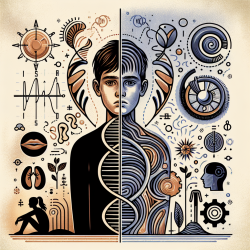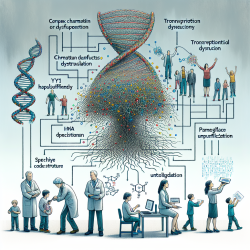Introduction
Depressive symptoms in adolescents are a growing concern worldwide, with significant implications for mental health development. A recent study, The association of FKBP5 gene methylation, adolescents’ sex, and depressive symptoms among Chinese adolescents: a nested case-control study, explores the complex interplay between genetic, environmental, and social factors in adolescent depression. Understanding these associations can guide practitioners in developing data-driven interventions to improve outcomes for young individuals.
Key Findings
The study highlights the role of the FKBP5 gene in regulating stress responses, with DNA methylation patterns potentially serving as biomarkers for depressive symptoms. Key findings include:
- Lower methylation levels of FKBP5 were observed in adolescents with persistent depressive symptoms compared to healthy controls, though statistical significance was lost after correction for multiple testing.
- No independent association was found between hypomethylation of FKBP5 and persistent depressive symptoms after adjusting for social-environmental factors.
- No significant sex differences were observed in the association between FKBP5 methylation and depressive symptoms.
Implications for Practitioners
Practitioners working with adolescents can draw several insights from this study:
- Integrating Genetic and Environmental Factors: Understanding the interaction between genetic predispositions and environmental influences can help tailor interventions that address both biological and social aspects of adolescent depression.
- Monitoring Methylation Patterns: While FKBP5 methylation alone may not be a definitive marker, it could be part of a broader assessment strategy to identify adolescents at risk for depression.
- Addressing Social-Environmental Factors: The study underscores the importance of considering family structure, socioeconomic status, and academic performance in assessing and addressing depressive symptoms.
Encouraging Further Research
While this study provides valuable insights, it also highlights the need for further research to explore the complex interactions between genetics and environment in adolescent depression. Practitioners are encouraged to stay informed about ongoing research and consider participating in or supporting studies that aim to deepen our understanding of these dynamics.
Conclusion
The study of FKBP5 gene methylation in adolescents offers a promising avenue for understanding the biological underpinnings of depression. By integrating genetic insights with environmental considerations, practitioners can enhance their approaches to supporting adolescent mental health. To read the original research paper, please follow this link: The association of FKBP5 gene methylation, adolescents’ sex, and depressive symptoms among Chinese adolescents: a nested case-control study.










